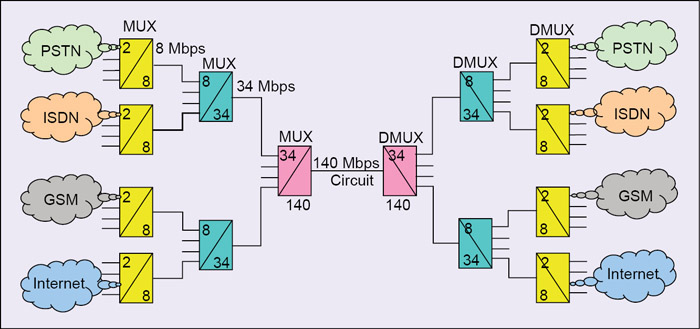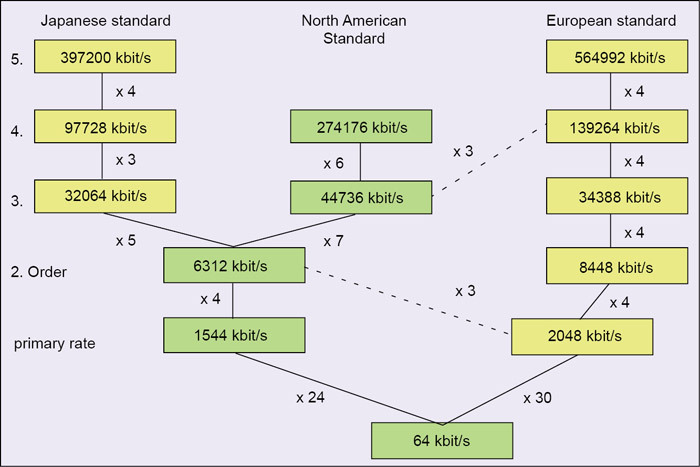Delivery of services like telephony, voice-over-IP, video streaming, telemedicine, broadcasting of TV programmes, high-speed file sharing, online banking, online video gaming, online education and shopping, needs a transmission network capable of very high data-rate transport capabilities. Innovation in the telecom industry has led to a new kind of multiplexing and de-multiplexing technique called plesiochronous digital hierarchy (PDH).

The term plesiochronous is derived from Greek plēsios, meaning near, and chronos, time. This ensures that PDH network elements run in nearly time synchronised manner. Multiplexing of several low data-rate channels is done to utilise the high data-rate transmission capacity of transmission media. The bit rates start with the basic multiplex rate of 2Mbit/s with further stages of 8, 34 and 140Mbit/s. Such a hierarchy is shown in Fig. 1. PDH networks provide circuits to switched public networks and may also be used to build synchronisation networks.
Evolution of PDH
With the introduction of pulse code modulation (PCM) technology in the 1960s, communication networks were gradually converted to digital technology over the next few years. PCM allows multiple use of a single line by means of digital time-domain multiplexing (TDM). The PCM involves sampling, quantisation and encoding. As a standard voice telephone signal has a bandwidth of 4kHz, it is sampled at twice the 4kHz frequency, that is, at 8kHz (Nyquist rate). Each sample is then converted to an 8-bit binary number. This occurs 8000 times per second.
Thus, if we multiply 8k samples/s × 8 bits/sample, we get the standard bit rate (= 64kbps) for a single voice channel. A transmission rate of 2048kbit/s (= 64kbps x (30+2)) results when 30 such coded channels are collected together into a frame along with the necessary signalling information (equivalent to two time slots). This so-called primary rate, 2048kbit/s, is used in most parts of the world.
The growing demand for more bandwidth meant that more stages of multiplexing were needed throughout the world. In order to meet the demand for higher bit-rates, the digital multiplex hierarchy PDH evolved in various parts of the world, differing with one another. PDH hierarchies developed and adopted by Europe, North America and Japan used different tributaries for multiplexing and de-multiplexing (Fig. 2).
In Europe, PDH adopts bit rates starting with the basic multiplex rate of 2048kbit/s ≅ 2 Mbit/s with further stages of 8, 34 and 140 Mbit/s. In this system, 30 channels are multiplexed together that results in 2.048Mbps basic rate, which is designated as E1. If four such lines are multiplexed together, and taking some framing bits, we get 4×30 channels = 120 channels = 8.448Mbps = E2 designation.

Multiplexing four E2 lines together we get 4×120 channels = 480 channels = 34.368 Mbps = E3 designation. Again, multiplexing four such E3 lines results in 4 x 480 channels = 1920 channels = 139.264Mbps = E4 designation. Further multiplexing such four E4 lines results in bit rate = 4 × 1920 channels = 7680 channels = 564.992Mbps = E5 designation.
The basic digital multiplexing standard established in the United States, called the Bell System Level 1 PCM Standard, or the Bell T1 Standard, multiplexes 24 separate voice channels together, resulting in a primary rate of 1544kbit/s. This basic rate is also being followed by Canada and Japan. In the USA’s (North American) DS1 System each voice channel is 64kbps and is designated as digital signalling Level 0, or DS-0. Each frame in the 24-channel multiplexer consists of 8 bits/channel × 24 channels + 1 framing bit = 193 bits. The total data rate when transmitting 24 channels is determined by 193 bits/frame × 8000 frames/s = 1.544Mbps = T1, or DS-1 designation.
If four T1 lines are multiplexed together, we get 4 × 24 channels = 96 channels = 6.312Mbps = T2, or DS-2 designation. Multiplexing seven T2 lines together we get 7 × 96 channels = 672 channels = 44.736Mbps = T3, or DS-3 designation. If six T3 lines are multiplexed together, we get 6 × 672 = 4032 channels = 274.176 Mbps = T4, or DS-4 designation.
Similar hierarchy has also been adopted by Japan, but with slight deviations at higher order multiplexing/de-multiplexing levels. Japanese PDH system multiplexes 24 channels together, which results in basic rate of 1544kbps. At the second order, four such lines are multiplexed together. Taking some framing bits, we get 4×24 channels = 96 channels = 6.312Mbps. At the third order level, five second order lines are multiplexed together resulting in 5 × 96 channels = 480 channels = 32.064Mbps. Again, multiplexing three such third order lines results in 3 × 480 channels = 1440 channels = 97.728Mbps. Multiplexing such four fourth order lines results in bit rate = 4 × 1440 channels = 5760 channels = 397.2Mbps.







